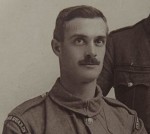 A previously unknown letter describing the famous Christmas Day soccer/football game between German and British troops held in No Man’s Land on the Western Front was revealed on the BBC’s Antiques Roadshow last month. It was written by Clement Barker of Ipswich, Suffolk, to his brother Montague on December 29th, 1914. A staff sergeant with the 1st Battalion Grenadier Guards, Barker wrote:
A previously unknown letter describing the famous Christmas Day soccer/football game between German and British troops held in No Man’s Land on the Western Front was revealed on the BBC’s Antiques Roadshow last month. It was written by Clement Barker of Ipswich, Suffolk, to his brother Montague on December 29th, 1914. A staff sergeant with the 1st Battalion Grenadier Guards, Barker wrote:
A messenger come over from the German lines and said that if we did not fire Xmas day, they (the Germans) wouldn’t so in the morning (Xmas day). A German looked over the trench – no shots – our men did the same, and then a few of our men went out and brought the dead in (69) and buried them and the next thing happened a football kicked out of our Trenches and Germans and English played football.
Night came and still no shots. Boxing day the same, and has remained so up to now.
This is an important contemporary eye-witness account of an event that even today is still questioned. Some historians have suggested that the football game was a later romanticization of the Christmas Day Truce events, that it never really happened. Soldiers’ letters testify that the match really did happen in the No Man’s Land between the trenches near Armentières, France, and that the Germans won 3-2.
Christmas Truces, mainly between British and German troops, broke out spontaneously at various points along the Western Front in 1914. The commands on both sides were not pleased. They considered it damaging to morale and a dangerous contravention of their propaganda programs which relied on demonizing the enemy to rally pro-war sentiment. After the events of Christmas 1914, troops were warned that any fraternization with the enemy would result in harsh punishment up to and including summary execution.
The letter was recently discovered by Rodney Barker, Sgt. Barker’s nephew. He found it when he was look through some of his father’s personal effects after his mother died. He never met his uncle who survived World War I but died in 1945 at age 61.
An interesting postscript to his description of the truce is a sadly inaccurate prognostication:
Our batt[allio]n went in the trenches again on Boxing Day. We have conversed with the Germans and they all seem to be very much fed up and heaps of them are deserting. Some have given themselves up as prisoners, so things are looking quite rosy.
It would take four years and more than 16 million deaths before the war’s end.
Every Australian knows the story of sport (and good will) between Germans and the Allies in the early years of the war. I have even seen it included in modern films set in WW1. But I have never seen contemporary proof. Well done, Antique Road Show – hopefully the letter went to a top quality museum.
What is fascinating is that the commands on both sides were not pleased with the spontaneously organised Christmas sporting matches. Damaging to morale? A dangerous contravention of their propaganda programmes? The notion of summary execution because of some peace and pleasure between 18 year olds at Christmas was insanity.
It truly is sick to think of these generals shooting their men for taking a day off slaughter. That’s how terrified they were of mutual understanding.
I was glad to see that Mr. Barker recognize its historical value is far greater than its market value. It’s times like these when you see that the valuation model of Antiques Roadshow is such a poor standard with which to judge our material culture. That letter is worth so much more than the measly 150 pounds some collector might be willing to pay for it.
Merry Christmas all!
Merry Christmas, fellow HistoryBloggians!
Merry Christmas, my fellow history nerds! May your present hauls be copious. :boogie:
The fraternization was sporadic, which may explain why it was easy to dismiss at the time. Strange that it should be disbelieved when you consider the amount of propaganda nonsense that was lapped up wholesale at the time. I suppose the grotesque goes over more easily than the inspiring. (I am a little skeptical about the comment of Germans deserting in droves. A little something for home consumption? Worth investigating, at any rate.)
As to the monetary value, well, sad, but then again, human nature to want a means of keeping count.
Sporadic as in – this section of the front line but not the next.
I went to a remote hilltop ruin in Guatemala for the Mayan calender change. The message from the Maya priests was peace and fellowship for all. The Guatemalan government sent 300 army and police to keep an eye on the 300 Maya who were there. The Maya were happy to see my wife and I, asked that we have our picture taken with their children, the military did not want their picture taken at all. Primary source history is the best, it makes the lying a bit harder.